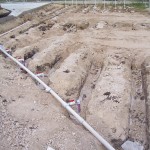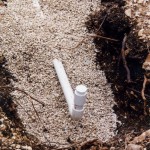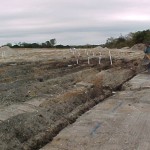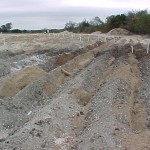For service call (210) 890-2778
or click here to request service
Low Pressure Dosing System
A low-pressure dosing system (LPD) treats wastewater then pumps it into the soil several times daily. Of the nonstandard drain fields, it is the least expensive to install and operate.
The system generally has three components:
- a series of tanks or compartmented tanks used to settle out and partially treat the wastewater
- a pump tank for dosing wastewater to the distribution system
- a system for distributing the wastewater into the soil
The pump tank houses a pump that discharges wastewater to the discharge system three or four times a day. The distribution system consists of a small pipe with holes drilled in it, laid in narrow 6 to 12 inch-wide trenches. The pump discharges wastewater to the trenches. Once in the trench, the wastewater seeps into the soil.
The soil provides most of the wastewater treatment. Soil particles filter solids and organic matter from the wastewater. Microbes in the soil break down the solids and kill the bacteria and pathogens in the wastewater.
The sizes of the septic tank, pump tank, and distribution system are based on the number of bedrooms in the house and the type of soil where the distribution system will be placed.
Advantages of LPD systems
- For installation and operation, the low-pressure dosing system is the least expensive of the nonstandard distribution systems.
- A low pressure-dosing system can be used in clay soils and relatively shallow soils. One foot of soil must be maintained between the bottom of the trench and the restrictive layer or fractured soil.
- The system can be designed and installed to work on sloping sites.
Disadvantages of LPD systems
- Low pressure-dosing systems cannot be installed in soils that become saturated during wet periods of the year or in shallow soils.
- Two feet of separation is required between the bottom of the trench and the saturated soil layer or groundwater.
- Electrical and mechanical components require electricity for operation and replacement when the components break.
Keeping a LPD working
- Pump the septic tanks a minimum of every 2 to 3 years.
- Inspect the pump and alarm system once a year.
- Flush the distribution lines every five years to remove sediment from the lines.
Reference: Lesikar, Bruce. Agricultural Communications, The Texas A&M University System. Low-pressure dosing. Publication L-5235. 6 Sept. 1999.





